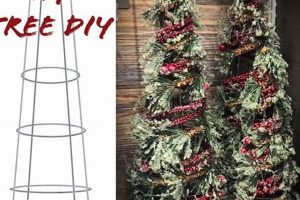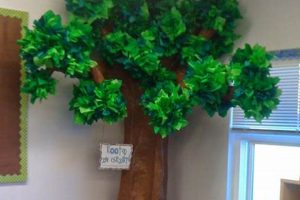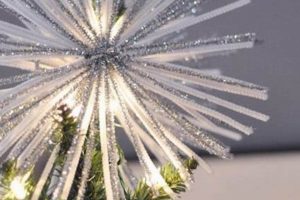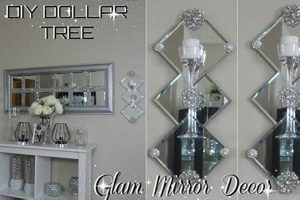A handcrafted decorative covering placed around the base of a Christmas tree is a significant element in holiday dcor. It serves to conceal the tree stand, electrical cords, and any other functional but visually unappealing components. For instance, a circular piece of fabric with a festive pattern, carefully positioned to encircle the tree’s base, exemplifies this decorative item.
The importance of such a creation lies in its ability to enhance the overall aesthetic of the Christmas tree display. It contributes to a polished and cohesive look, unifying the tree with the surrounding environment. Historically, these coverings have evolved from simple cloths to elaborate designs, reflecting changes in crafting techniques and personal styles. Benefits include the opportunity to personalize holiday decorations, reduce waste by repurposing materials, and create a unique and cherished heirloom.
The subsequent sections will explore a variety of crafting methods, material selections, and design considerations for creating individualized and aesthetically pleasing decorations to complete the Christmas tree’s presentation.
Crafting the Ideal Decorative Base Covering
The following guidelines provide insight into achieving a refined and personalized aesthetic when constructing a custom decorative base covering for a Christmas tree.
Tip 1: Fabric Selection: Prioritize durable, stain-resistant materials suitable for floor placement. Consider the existing color palette of the holiday dcor to ensure cohesion. Linen, felt, or upholstery fabrics are viable options.
Tip 2: Accurate Measurement: Determine the appropriate diameter by measuring the tree’s widest point. The covering’s diameter should extend at least 6 inches beyond this point to maintain visual balance.
Tip 3: Pattern Precision: Utilize a pre-existing template or draft a custom pattern on paper before cutting fabric. Accuracy in pattern creation minimizes fabric waste and ensures a symmetrical finished product.
Tip 4: Secure Fastenings: Implement a reliable closure system, such as hook-and-loop fasteners, ties, or buttons, to maintain the covering’s position around the tree base. Secure closures prevent shifting and maintain a tidy appearance.
Tip 5: Interlining Reinforcement: Incorporate a layer of interfacing or batting to provide structure and prevent fabric sagging. Interlining also adds thermal insulation, which may be beneficial on uninsulated floors.
Tip 6: Edge Finishing: Employ a professional edge finishing technique, such as bias tape binding or serging, to prevent fraying and enhance durability. A neatly finished edge contributes to a polished and professional appearance.
Tip 7: Embellishment Restraint: When adding embellishments, such as beads or sequins, exercise moderation. Over-embellishment can detract from the overall aesthetic and create a cluttered appearance. Opt for subtle, complementary details.
Adherence to these guidelines ensures the creation of a durable, aesthetically pleasing, and functional decorative base covering that enhances the overall presentation of the Christmas tree.
The concluding section will explore additional design variations and innovative approaches to creating a truly unique holiday centerpiece.
1. Material Selection
Material selection is a pivotal determinant in the design and construction of a handcrafted decorative base covering for a Christmas tree. The choice of fabric directly influences the aesthetic appeal, durability, and overall functionality of this seasonal embellishment.
- Aesthetic Harmony
Material selection dictates the visual synergy between the decorative base covering and the existing holiday decor. The texture, color, and pattern of the chosen fabric contribute significantly to the overall festive ambiance. For instance, a rustic burlap material evokes a traditional, homespun aesthetic, while a luxurious velvet conveys a sense of elegance and sophistication. Inharmonious material choices can detract from the tree’s visual impact.
- Durability and Longevity
The selected material must withstand repeated use and potential wear and tear. Fabrics such as felt, canvas, or upholstery-grade materials offer superior durability compared to more delicate options like silk or lace. A robust material ensures the longevity of the tree covering, preserving its aesthetic value over successive holiday seasons. Insufficient durability necessitates frequent repairs or replacements.
- Maintenance Requirements
Different materials exhibit varying maintenance needs. Stain resistance and ease of cleaning are crucial considerations, particularly in households with children or pets. Fabrics that are easily washable or stain-resistant, such as polyester blends, minimize maintenance efforts. Materials prone to staining or requiring professional cleaning may prove impractical for a heavily used decorative item.
- Cost Effectiveness
The cost of the selected material directly impacts the overall project budget. Budget-conscious crafters may opt for readily available and affordable materials like cotton or recycled fabrics. Conversely, those seeking a more luxurious aesthetic may choose higher-end materials such as velvet or silk, incurring a greater expense. A balanced approach considers both aesthetic preferences and budgetary constraints.
The ramifications of material selection extend beyond mere aesthetics. The chosen fabric impacts durability, maintenance, and cost, ultimately shaping the overall value and longevity of the handcrafted decorative base covering. Therefore, a careful and informed selection process is paramount to creating a successful and cherished holiday adornment.
2. Diameter Measurement
Diameter measurement constitutes a critical preliminary step in the creation of a handcrafted decorative base covering for a Christmas tree. Incorrect measurement can lead to a covering that is either too small to conceal the tree stand adequately or excessively large, resulting in an unkempt and visually displeasing arrangement. The diameter, in this context, refers to the widest span of the assembled Christmas tree at its base. This measurement directly dictates the required dimensions of the decorative covering.
The consequences of inaccurate diameter measurement are manifold. A base covering that is too small exposes the tree stand, electrical cords, and other functional elements intended to be concealed, thereby diminishing the aesthetic appeal of the entire display. Conversely, an oversized covering can bunch and wrinkle, creating a tripping hazard and detracting from the tree’s presentation. For example, if a tree has a base diameter of 48 inches, a covering with a diameter of only 40 inches will fail to provide adequate coverage. Conversely, a covering with a diameter of 72 inches would create excessive fabric overflow. An accurate measurement, augmented by an additional allowance of approximately 6-12 inches for visual balance, is essential.
Effective diameter measurement involves utilizing a flexible measuring tape extended across the widest point of the tree base after the tree has been fully assembled and positioned in its stand. The resulting measurement serves as the foundation for pattern drafting and fabric cutting. A correctly sized base covering contributes significantly to the cohesive and polished appearance of the Christmas tree, enhancing its visual impact and minimizing potential safety hazards. The integration of precise diameter measurement ensures a functional and aesthetically pleasing finished product.
3. Pattern Design
Pattern design functions as a foundational element in the creation of a decorative base covering for a Christmas tree. The design dictates the shape, size, and overall aesthetic of the finished product. A well-executed pattern ensures a symmetrical, visually appealing, and functionally effective covering. Conversely, a poorly conceived pattern can result in a misshapen or ill-fitting covering, undermining the entire crafting effort. For example, a simple circular pattern with a central opening is a common starting point, but variations in scalloped edges, appliqued motifs, or quilted textures require more complex patterns. The pattern directly determines the amount of fabric required, minimizing waste and maximizing resource efficiency.
The selection and implementation of a pattern are inherently connected to the crafter’s skill level and desired complexity of the finished piece. A novice may opt for a straightforward, single-piece pattern, while an experienced seamstress might tackle a multi-paneled design with intricate embellishments. Furthermore, the intended placement and style of the tree influence the pattern choice. A traditional tree in a formal setting may benefit from a classic, symmetrical pattern with understated details. A more contemporary or whimsical tree might inspire a bolder, asymmetrical design with vibrant colors and playful textures. The correlation between pattern design and tree style is a key determinant of the overall aesthetic harmony.
In summation, pattern design forms the backbone of the handcrafted tree base covering project. It directly impacts the visual appeal, functionality, and resource utilization. The pattern selection process should carefully consider the crafter’s skill, the desired aesthetic, and the existing style of the Christmas tree. This careful consideration will likely produce a visually pleasing and functional product.
4. Closure Mechanism
The closure mechanism represents a critical functional component of a handcrafted decorative base covering for a Christmas tree. It directly impacts the ease of use, security, and overall aesthetic appeal of the finished item. The purpose of the closure is to securely encircle the tree stand, concealing it from view while allowing for convenient removal and replacement as needed. Failure to incorporate an effective closure results in a covering that shifts, gaps, or requires laborious adjustments, undermining its intended purpose. A poorly designed or absent closure compromises both the visual presentation and the practical utility of the decorative item. For instance, a covering without any closure is prone to constant displacement, exposing unsightly elements and requiring frequent repositioning. In contrast, a well-engineered closure maintains a clean, uniform appearance, enhancing the overall aesthetic.
Various closure mechanisms can be integrated into the design of a tree base covering, each offering distinct advantages and disadvantages. Hook-and-loop fasteners provide a simple and adjustable solution, allowing for easy opening and closing. Ties, whether ribbons or fabric strips, offer a decorative element while securing the covering. Buttons and buttonholes create a more traditional and refined aesthetic, but require greater precision during construction. Zippers provide a secure and concealed closure, but may be more challenging to install. The selection of a specific closure mechanism should consider factors such as the desired aesthetic, the crafter’s skill level, and the anticipated frequency of removal and replacement. A robust and aesthetically appropriate closure significantly enhances the practicality and longevity of the decorative tree base covering.
In conclusion, the closure mechanism is not merely an ancillary feature but an integral component of a well-designed tree base covering. Its effectiveness directly determines the item’s ease of use, security, and overall aesthetic appeal. Selection of a closure that aligns with the project’s design goals and the crafter’s capabilities is crucial for achieving a functional and visually pleasing finished product. The success of this element will make or break the overall function of the project.
5. Edge Finishing
Edge finishing represents a critical stage in the fabrication of a handcrafted decorative base covering for a Christmas tree. This process directly impacts the durability, aesthetic appeal, and overall longevity of the finished item. Effective edge finishing techniques prevent fraying, reinforce seams, and contribute significantly to a polished, professional appearance.
- Fray Prevention
The primary function of edge finishing is to prevent the raw edges of the fabric from unraveling. Unfinished edges are susceptible to fraying, which can progressively degrade the fabric and diminish the covering’s lifespan. Techniques such as serging, zigzag stitching, or bias tape binding encapsulate the raw edges, preventing fraying and maintaining the integrity of the fabric over time. For example, a covering constructed from loosely woven burlap would necessitate robust edge finishing to prevent significant fraying with regular use.
- Seam Reinforcement
Edge finishing techniques can also reinforce seams, particularly in multi-paneled designs. Applying binding or using a serger to finish seam allowances provides additional strength and prevents seams from separating under stress. A poorly finished seam is a potential point of failure, compromising the structural integrity of the covering. Reinforcement is particularly crucial in areas subject to tension, such as corners or areas around closure mechanisms.
- Aesthetic Enhancement
The choice of edge finishing technique significantly influences the overall aesthetic of the tree base covering. Options such as decorative stitching, contrasting bias tape, or lace trim can add visual interest and complement the overall design. A carefully chosen edge finish elevates the appearance of the covering, contributing to a polished and professional look. Conversely, a poorly executed or mismatched edge finish can detract from the overall aesthetic.
- Durability and Maintenance
Certain edge finishing techniques enhance the durability and ease of maintenance of the tree base covering. For example, bias tape binding can protect edges from abrasion and staining, while serging provides a neat and durable finish that is resistant to unraveling. Easy-to-clean edge finishes reduce the need for frequent maintenance and prolong the lifespan of the covering. Fabrics that can withstand frequent washing are preferable, especially in homes with children or pets.
In summary, the selection and execution of edge finishing techniques are crucial for creating a durable, aesthetically pleasing, and long-lasting tree base covering. The chosen method should effectively prevent fraying, reinforce seams, enhance the overall aesthetic, and promote ease of maintenance, ultimately contributing to a successful and cherished holiday decoration.
6. Embellishment Style
Embellishment style significantly impacts the overall aesthetic and perceived value of a handcrafted decorative base covering, functionally linking its design to its visual appeal. The specific embellishments incorporated, or omitted, directly influence the piece’s ability to complement the Christmas tree and the surrounding environment. A considered embellishment style can elevate a simple fabric covering into a focal point; a poorly chosen style diminishes the intended festive ambiance. For example, the addition of hand-stitched embroidery depicting winter scenes can transform a plain linen covering into a cherished family heirloom, reflecting a classic, personalized aesthetic. Conversely, excessive or mismatched embellishments, such as garish sequins on a rustic burlap covering, create visual disharmony, reducing its perceived quality and aesthetic value. Embellishment, therefore, requires a balanced approach, reflecting conscious artistic and functional intent.
The selection of embellishments should align with the broader theme of the holiday dcor. For a minimalist aesthetic, subtle additions such as delicate lace trim or understated metallic accents may be appropriate. In contrast, a more traditional or maximalist approach might involve incorporating elaborate appliqus, intricate beadwork, or hand-painted motifs. The choice of materials also plays a critical role; felt appliqus offer a soft, tactile dimension, while metallic threads provide a subtle shimmer. Furthermore, the scale and placement of embellishments require careful consideration. Overly large or densely packed embellishments can overwhelm the design, while sparsely distributed embellishments may appear insignificant. Proper application involves a balanced composition that accentuates the overall design without detracting from the tree itself. Successful implementation depends on careful thought about balance, design, and cohesion to the larger theme.
In summation, embellishment style is not an arbitrary addition to a handcrafted tree base covering, but an integral design element that directly affects its aesthetic success. The selection and application of embellishments require careful consideration of the overall theme, material compatibility, and compositional balance. Challenges lie in achieving a harmonious design that complements the tree and surrounding environment. A thoughtfully embellished tree base covering elevates the overall holiday aesthetic, while a poorly executed style diminishes its visual impact and perceived value.
7. Durability Assessment
Durability assessment, in the context of a handcrafted decorative base covering for a Christmas tree, constitutes a critical evaluation of its capacity to withstand repeated use, environmental factors, and potential physical stressors over an extended period. The durability directly correlates with the covering’s longevity and overall value proposition. A comprehensive durability assessment prior to and during the crafting process mitigates the risk of premature wear, tear, or material degradation, thereby maximizing the investment of time and resources. For example, a covering constructed from delicate fabrics lacking reinforcement may exhibit significant wear after a single holiday season, necessitating costly repairs or replacements. The impact of durability assessment is therefore manifest in both the immediate presentation and the long-term cost-effectiveness of the finished item.
Practical applications of durability assessment involve several key considerations. Material selection plays a crucial role; fabrics resistant to abrasion, staining, and fading are prioritized. Seam strength is evaluated, with reinforced seams and robust stitching techniques employed to prevent separation under stress. Edge finishing methods are scrutinized for their ability to prevent fraying and unraveling. The closure mechanism is assessed for its capacity to withstand repeated opening and closing cycles without failure. Real-world examples illustrate the importance of these considerations: a covering exposed to heavy foot traffic requires more durable materials and construction techniques than one placed in a low-traffic area. In homes with pets or small children, stain-resistant fabrics and secure fastenings become paramount. These assessments determine the necessary enhancements.
In conclusion, durability assessment forms an indispensable component in the creation of a handcrafted tree base covering. It’s careful consideration informs design decisions, material selection, and construction methods, ensuring the finished product withstands the rigors of seasonal use and maintains its aesthetic appeal over time. Addressing challenges such as unexpected material weaknesses or unforeseen environmental factors requires a proactive and iterative assessment process. The long-term success and value of a project depend on the adherence to durability standards. A failure to integrate durability considerations leads to an inferior product with compromised functionality. The process ensures a long-lasting aesthetic product.
Frequently Asked Questions
The following addresses common inquiries and misconceptions regarding the creation and utilization of handcrafted decorative base coverings for Christmas trees.
Question 1: What is the optimal size for a tree base covering?
The ideal size is determined by measuring the diameter of the tree’s widest point. The covering should extend at least 6 inches beyond this measurement on all sides to ensure complete concealment of the tree stand and a balanced visual aesthetic.
Question 2: What types of fabric are suitable for tree base coverings?
Durable, stain-resistant fabrics are recommended. Linen, felt, canvas, and upholstery-grade materials offer both aesthetic appeal and functional longevity. Delicate fabrics such as silk or lace may be less practical due to their susceptibility to wear and tear.
Question 3: How can fraying be prevented on a fabric tree base covering?
Employing appropriate edge finishing techniques is crucial. Serging, zigzag stitching, bias tape binding, or the application of fabric sealant can effectively prevent fraying and maintain the integrity of the fabric edges.
Question 4: What is the purpose of a closure mechanism on a tree base covering?
The closure mechanism, such as hook-and-loop fasteners, ties, or buttons, secures the covering around the base of the tree. It prevents shifting, maintains a neat appearance, and allows for easy removal and replacement when necessary.
Question 5: How can a tree base covering be effectively cleaned and maintained?
Cleaning instructions depend on the fabric type. Many fabrics can be spot-cleaned with a mild detergent and water. Machine-washable fabrics should be laundered according to the manufacturer’s instructions. Regular vacuuming can help remove dust and debris.
Question 6: Can a tree base covering be repurposed after the holiday season?
Yes, a tree base covering can be repurposed for various uses. It can be transformed into decorative pillows, storage containers, or other craft projects, thereby extending its lifespan and minimizing waste.
These frequently asked questions provide a foundation for understanding the key considerations involved in creating and maintaining a decorative tree base covering. Applying this information helps to create a visually appealing and long-lasting addition to the holiday decor.
The following will cover innovative customization strategies to personalize these decorative additions.
DIY Tree Skirt
The preceding analysis has elucidated the various facets of crafting a decorative base covering for a Christmas tree. From the initial material selection to the implementation of edge finishing and the consideration of long-term durability, each step requires careful consideration. The diameter measurement and pattern design form the foundational elements, while closure mechanisms and embellishment styles contribute to the functional and aesthetic qualities of the finished piece. This is all for the intent of having a quality DIY tree skirt.
The creation of a base covering is not merely a decorative exercise; it represents an investment in both aesthetic enhancement and long-term utility. As holiday decorating traditions evolve, the ability to adapt and personalize these elements will remain paramount. The ongoing refinement of crafting techniques and material selection will ensure that decorative base coverings continue to contribute to the visual harmony and festive spirit of the holiday season. Continued engagement with DIY tree skirt projects guarantees not only the enhancement of personal spaces but the preservation of valuable crafting skills. It provides a lasting family tradition.







